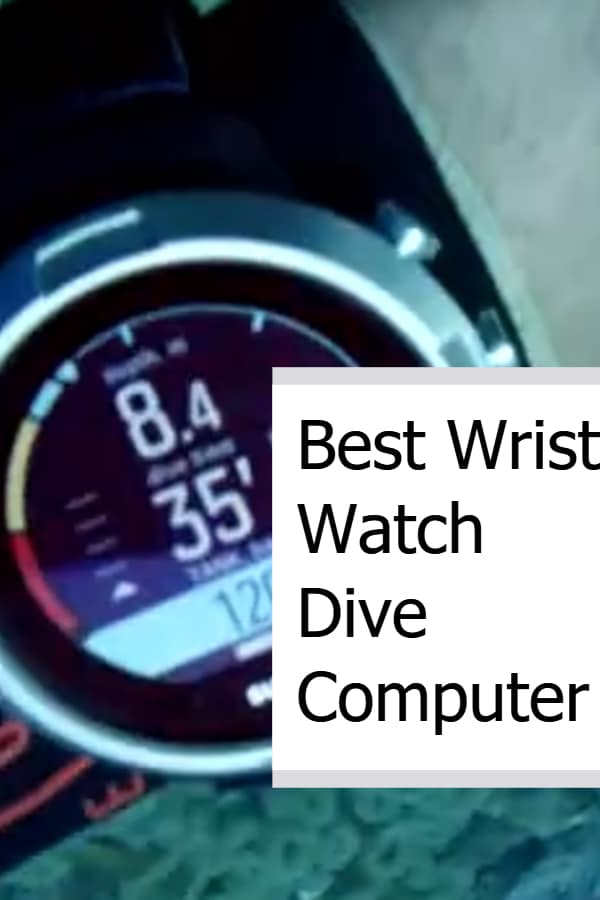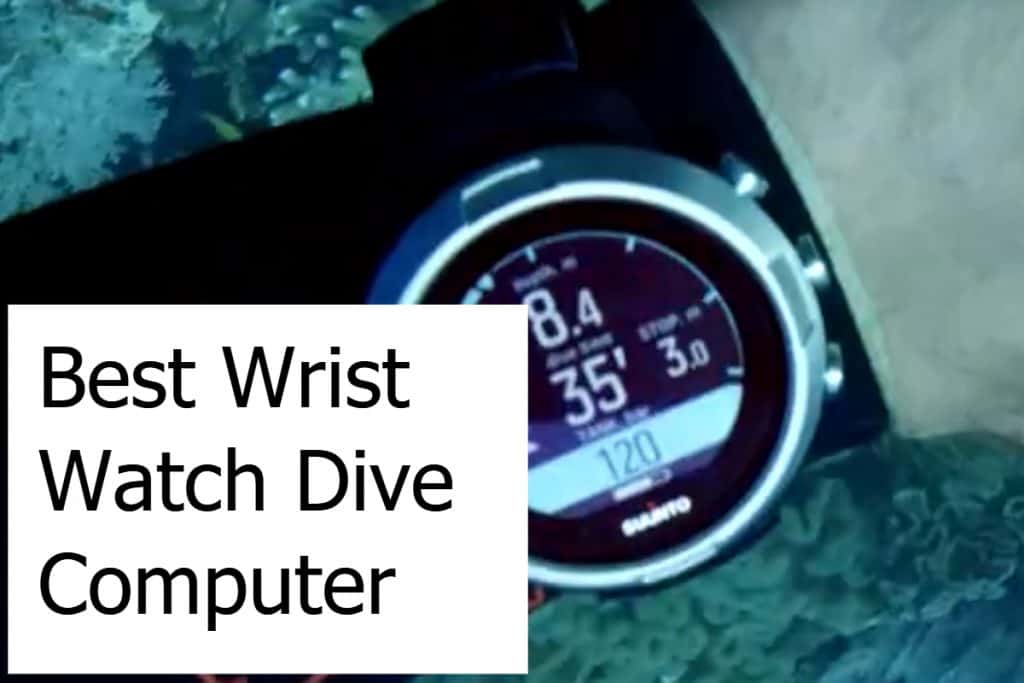Shearwater Teric vs. Suunto D5 vs. Garmin Descent Mk1 – Best Wrist Watch Dive Computer (2023)!
We are comparing some of the most exciting new wrist-mounted dive computers that you can get right now. We’re looking at the Shearwater Teric and comparing it to the Suunto D5 and the Garmin Descent Mk1. Which of these three is the best wrist dive computer? Is any of them a good entry-level device? Let’s find out!
The Shearwater Research Teric was the first of the bunch to come out with a set of incredible features and a display that is simply awesome. It was clear that Suunto won’t be left behind so they introduced the D5 not too long ago to match the Shearwater contender in capabilities as well as looks.
The Descent Mk1 from Garmin matches the other two devices in functionality. It might fall a little short when it comes to the display though.
All three units are wearable wrist dive computers that you can use as a watch. Well, you can if you have a wrist that is on the larger side. If you’re 5 feet tall and weigh 90 pounds then you probably do not want either of these units as your day-to-day watch!
Made for Recreational Diving including Multi-Gas Mixes
These dive computers offer the required features for a recreational diver. In the case of the Teric and Mk1 you even get capabilities to dive with Trimix or with a rebreather. All of them can handle multiple gasses and can deal with Air Nitrox up to 100%.
User Changeable Battery
None of the dive computers that we’re looking at in this comparison requires a user replaceable battery. All models have batteries that can be recharged and therefore, they are not user changeable.
If the battery at one point no longer charges, then you’ll have to send the unit to a service center to get the battery replaced. As mentioned, none of these diving computers has a user-replaceable battery.
Display
Hands down, the best screen of the three comes with the Shearwater Teric. The display is easy to read, the numbers and letters are bold and super clear. Shearwater did a fantastic job to use the real estate of the display perfectly with everything cleanly being in its place.
Suunto D5 Easy to Read Color Display
The D5’s display is clear and bright. You can customize the screen and what you’ll see so it’s easy to make this device your own. In the end, it feels just a little less clear and clean compared to the Teric but is, without doubt, easy to read compared to many older scuba diving computers.
Garmin Descent Mk1 Screen
The Descent Mk1 shows that it’s not a dive computer that doubles as a daily watch but instead a fitness watch that doubles as a dive computer. The numbers seem on the small side and the screen is just not as bright as the other two contenders. The information is just not as easy to read as it is on the other two models.
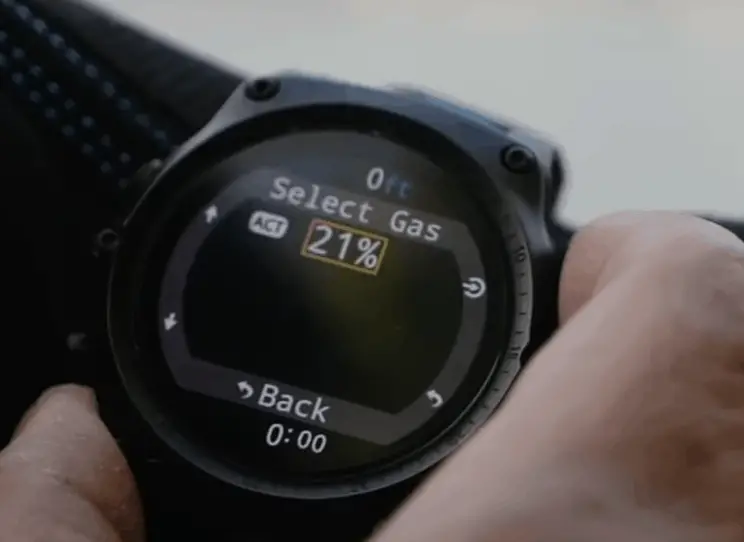
Navigation
The last thing you want is to have to study for a long time to figure out navigation on your dive computer. All of these contenders offer easy-to-use navigation and the options available between all three units are pretty much the same.
None of these sophisticated dive computers could be easily navigated through a single button navigation system. They all come with at least three buttons instead of a single button as you can find on some entry-level dive computers.
Suunto D5 Three-Button Navigation
The Suunto D5 comes with a three-button user interface. It is kept very intuitive with the central button being used to cycle through the whole menu items and screens.
Inside a specific menu, you can cycle through the different options with the same button. If you hold it down you’ll go back to the next higher menu.
Navigating the Shearwater Research Teric
The Shearwater Teric, on the other hand, comes with a four-button interface. It’s as intuitive as the D5’s, yet quite different. Each button offers specific functionality and navigation options based on the menu you’re in.
It overall is probably a little easier to use and faster to go through the settings compared to the three buttons on the Suunto.
Menu Navigation on the Mk1
The Descent Mk1 has a whopping five buttons to navigate and control the watch. The navigation is a little overwhelming.
That is due to the fact that this unit is not just a dive computer and a watch. It’s also a fitness tracker that does add quite a few menu choices and makes the overall navigation more complicated.
That’s not to say that you won’t end up getting familiar with all choices and being able to get to where you want within the menus. But, it will most likely take you longer compared to the Suunto D5 or Shearwater dive computer.
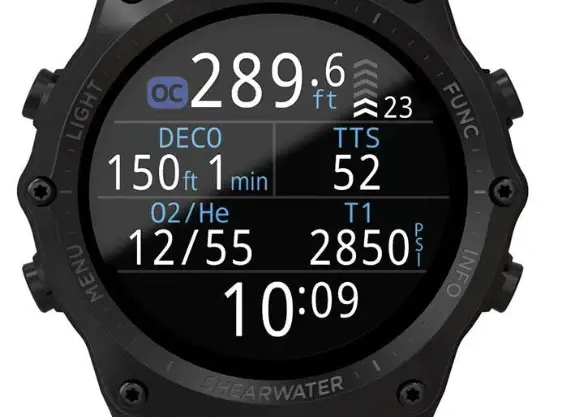
Menu Setup and Navigation
The D5 dive computer has the best software setup of the three. It’s easy to navigate through the menu choices and then end up with the information you were looking for.
The software is optimized well to work with the navigation buttons and make it easy to find the data you want. The air integration features are easily accessible and clearly show the remaining gas, etc.
Teric Menu Choices
The Teric takes second place for the software and menu navigation of these three wrist-watch dive computers. It makes it easy to find what you’re looking for without having to press the buttons excessively. When diving with air integration (Find the Best Air Integrated Wrist Dive Computer) you also can clearly get the picture of remaining gasses, etc.
Many menu selections on the Descent Mk1
The Descent Mk1 from Garmin is also easy to use and the menu and navigation are straightforward. We rate it a little lower as you have many more menu choices due to it being a fitness tracker with many more activities being tracked than just diving.
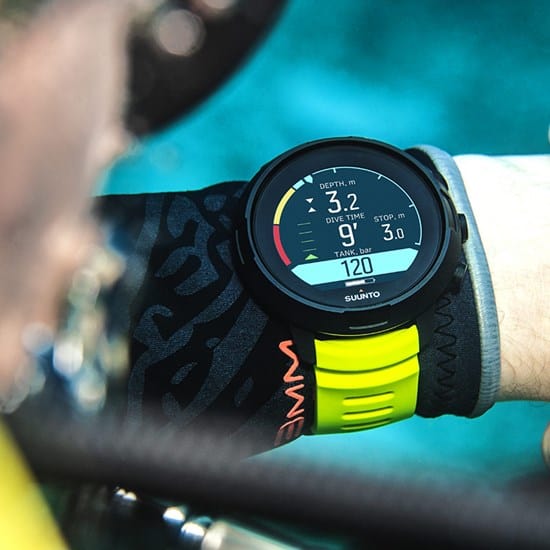
Algorithms
Both the Descent Mk1 and the Shearwater dive computer use a Bühlmann ZHL-16C algorithm with gradient factors. Suunto uses its own RGBM Fused 2 algorithm.
It’s well-known that Suunto’s algorithm is rather conservative. However, you can adjust the calculations and pick the aggressive mode. That will get you close to the Bühlmann calculations.
No matter what though, either of these algorithms keeps you safe. Even at the most aggressive settings you’ll end up on the safe side and should, under normal circumstances, never get into any place where your health is at risk.
All three algorithms are capable to handle Air Nitrox gas mixes. These three wrist computers can handle Air Nitrox levels up to 100%.
Air Integration
The Suunto and Shearwater offer optional air integration. The wireless air integration can handle connecting to multiple transmitters so you can keep an eye on the pressure in the tank and let you know how much more air you have.
The Descent Mk1 does not have wireless air integration. You will need a console with a pressure gauge to keep track of the fill-level in your tank(s) and get air integration through a hose.
Battery Life
All three of these units are more than just a dive computer. You can and most likely will wear them every day. All three devices have rechargeable batteries. This means that none of these units has a user-replaceable battery.
If it’s just a dive computer you can live with a battery life that requires recharging every few days. However, when you use it as your everyday watch then you certainly do not want to have to recharge or even change the batteries every couple of days!
Use as your everyday watch!
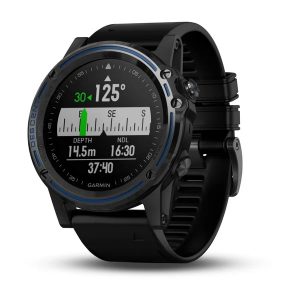
The Shearwater Teric and the D5 double-up as your everyday watch and your scuba computer. Both provide quite a lot of battery life and you can expect the Shearwater to last you longer on a charge.
With a lot of diving, you can still expect not to have to recharge more than once a week. The Suunto unit needs recharging a little more often and will not last that long.
Fitness Tracker integrated
The Garmin, on the other hand, is additionally a fitness tracker and smartwatch. You will use that watch more than the other two simply to count your steps or track other fitness activities every day.
It’ll also notify you of emails and text messages that you received. The Mk1 is always on and it’s no surprise that it uses more battery than the other two
This will result in more demands on the battery and the Descent Mk1 does handle it well. It does need recharging more often than the Teric, but not quite as often as the D 5.
The batteries in these models are part of the device and do not come with a user-replaceable battery.
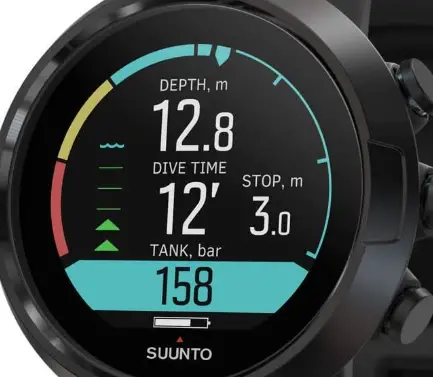
Daily Use
All three dive computers can be used as your daily watch. Dive computers of that size are a great watch for many, if not most, wrists.
These dive computers come with the standard functions you’d expect from a modern wristwatch. You can get the current time and date as well as alarms with either one of them.
The fact that these dive watches can be worn daily is also visible when you look at the straps. While traditional wrist dive computers have a long piece of silicone strap to wrap around your wrist, these have high-end, colorful watchbands that you expect on any high-end watch.
Personalization
The Garmin Mk1 dive computer does have a lot of different strap options ranging from leather straps to various colored Silicone variants, metal versions including even a titanium one. When you choose one of the metal straps then you want to use a silicone strap when you’re scuba diving.
The metal ones are designed so the strap won’t accidentally open when you wear the dive computer on your wrist. Yet, they won’t easily go over a wetsuit or gloves and a stretchable silicone strap is the better choice for a scuba trip. Garmin considered that in the design and made the straps super easy to switch out.
Straps for the Suunto D5
The D 5 has a number of different colored straps for scuba diving as well as textile and leather versions. Suunto does not offer a metal strap but otherwise, you get a variety for different occasions, whether you go diving or to a theater show. The straps are easily changed but not quite as simple as with the Descent Mk1 from Garmin.
Standard watch band size on the Teric
The Shearwater device goes a slightly different route. It comes with a few choices but as it is a standard watch band size, you can pick pretty much any strap you like and it will fit as they are user-changeable. The downside is that you do need to use tools to change the user-changeable strap.
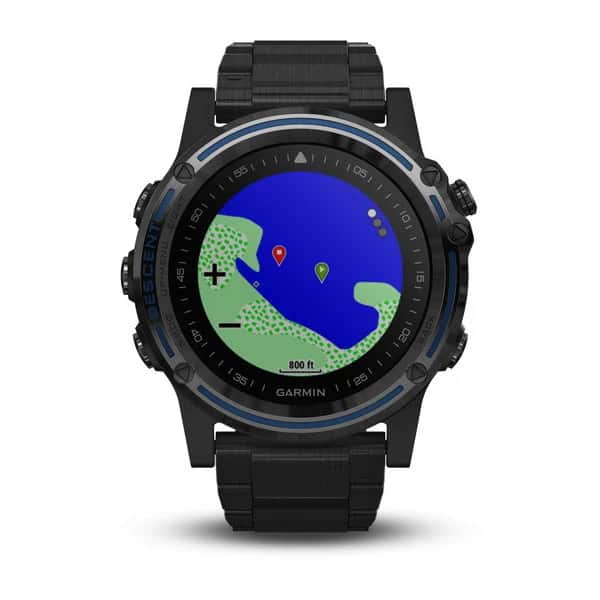
Dive Log
You can pretend that a solid dive log on a dive computer is not that important. Yet, nobody would want to miss being able to look through the data of previous dives.
You could stay stuck in the 19 hundreds and use a pen and paper log to report your dives. Or you could have a dive computer offer a reasonably sized dive log that you can review at your leisure.
All three of these dive computers offer an internal dive log that you can load onto your computer for further storage or easier review of the scuba diving data.
Largest Dive Log – Suunto D5
The Suunto D5 in our opinion has the best logging solution for scuba diving. It provides around 200 hours of dive time to be logged on the device itself. That’s enough space for around 400 dives.
You can then offload the data from the dive computer into the Suunto Movescount cloud system to display and enrich the data you gathered from your dives. The D 5 connects with Bluetooth to your app on your phone and you can offload the data that way. There’s no hassle with cables, etc.
Shearwater Teric Dive Log – Bluetooth Connectivity
The Shearwater Teric is not far behind the D5. It offers a larger capacity for the dive log on the device. You can store dive data at a 10-second sampling rate for dives covering 500 hours!
Similar to the D5 dive computer you can then also offload the data from your unit to your computer for further analysis and review. This can simply be done through Bluetooth connectivity and does not require any cables to connect.
Confusing Dive Log on the Mk1
The Garmin can store and exchange dive log data but is a little more confusing compared to the Teric and D5. The reason being that the Descent Mk1 is a smartwatch and fitness tracker.
The log is designed to keep information for all different kinds of activities including scuba diving. Therefore, it’s also impossible to say how many hours of dive time you can log.
Too much other data is logged in this dive computer and the available memory is not just for scuba diving logging. Data can be exchanged through a Bluetooth connection.
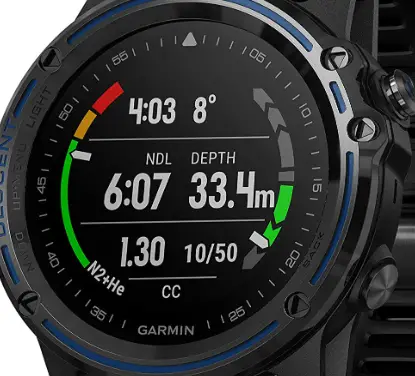
Other Features
Here’s where the Garmin shines. As it’s not just a dive computer and wristwatch, you get all the bells and whistles you’d expect from an activity or fitness tracker.
Fitness Tracker and Smartwatch – Garmin Descent Mk1
It records and displays different activities like running which makes it truly an outstanding compromise between a dive computer and an activity tracker. You can even get your location through the GPS connection. After connecting it to your phone you also get text messages, call information, etc. right onto your display.
However, we are specifically looking at these devices being used as dive computers. While it’s nice to have a complete fitness tracker in the form of the Descent Mk1 from Garmin, it’s not one of the basic requirements for a dive computer. In the end, all we want is to have it keep us safe while we dive.
All three devices are good dive computers that keep you safe during a dive. The Teric definitely is designed to just be a dive computer. An excellent one to be clear. It beats the Suunto dive computer in this category due to the fact that you can change the watch screen to have different faces. It also offers wireless charging and during a charge, the display turns so you can use it as a clock on your nightstand.
The D5 doesn’t offer many or any bells and whistles. It’s a dive computer and nothing else. There are no additional bells and whistles and for the purpose of diving, you also don’t need any additional features.
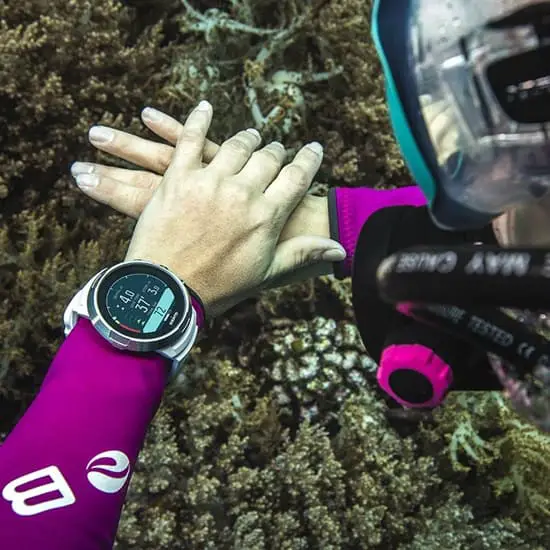
Final Thoughts
All three of these devices are great wrist dive computers. If you’re a recreational diver then you can’t go wrong with either one of them.
Are they Entry-Level dive computers?
While they are all easy to use, they are by no means limited in functionality and features like many entry-level dive computers. If you’re just starting with the sport then you might want to consider buying an entry-level model that will be cheaper and tailored to the features you need.
Enriched Air-Nitrox Capabilities – Can you use them with Trimix?
Each one of these dive computers allows for multiple gas mixes during a dive. All three can handle multiple Enriched Air Nitrox (EAN) mixes for diving. Both the Teric and the Descent Mk1 dive computer can handle dives with closed-circuit rebreathers. They also have the option to use them when scuba diving with trimix.
Best Wrist-Mounted Scuba Diving Computer
The Garmin is the most versatile as it’s a complete activity and fitness tracker. However, it does lack the wireless air integration and it can be just a little too much to have everything available and you need to step through the navigation.
The Teric, as mentioned above, offers the most dive related technology. Yet, for recreational diving, there’s no need to get all these bells and whistles. In addition, it does have the best and most cleaned up display of all of them.
Overall, as mentioned before, you can’t really go wrong with either one of these best dive computers for the wrist if you’re using them for recreational dives. All of them are easy to use with great displays and the convenience of rechargeable batteries. No need to fuss around with a user-replaceable battery.
All three models work well as your wristwatch dive computer whether you are looking for an entry-level device or a unit with all the bells and whistles. They keep you safe and if that’s all you need then you might want to pass on the Descent Mk1.
Garmin Descent Mk1 Wrist-Watch Dive Computer Conclusion
While the Mk1 tries to be a jack-of-all-trades, it’s not in our opinion. Lacking air integration does seem to limit the capabilities specifically for scuba diving.
It does make up for it by adding other features that are non-scuba. However, in this price category, you can typically expect your diving computer to have air integration, and as such the other two models might be a better fit.
Suunto D5 Wristwatch Scuba Computer Conclusion
The Suunto D5 is a really great dive computer. It does fall a little short in regards to features and functions compared to the Teric. If you’re trying to find the best wristwatch that can be a dive computer on occasion then the D5 is your best bet.
Shearwater Research Teric Wrist-Mounted Diving Computer Conclusion
However, if you’re trying to find the best dive computer which you also can use as a wristwatch, then the Teric is your choice as one of the best wrist-watch dive computers.
Similarly, if you want a fitness tracker that you also can use as a dive computer, then the Descent Mk1 from Garmin is your best dive computer for wearing at your wrist!
Please use the image below to pin this post on the best dive computers to Pinterest!
